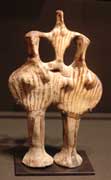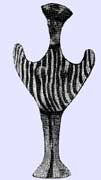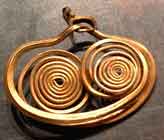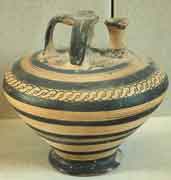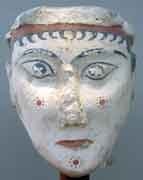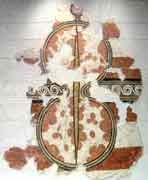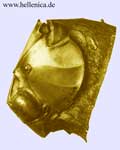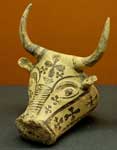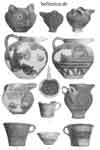.
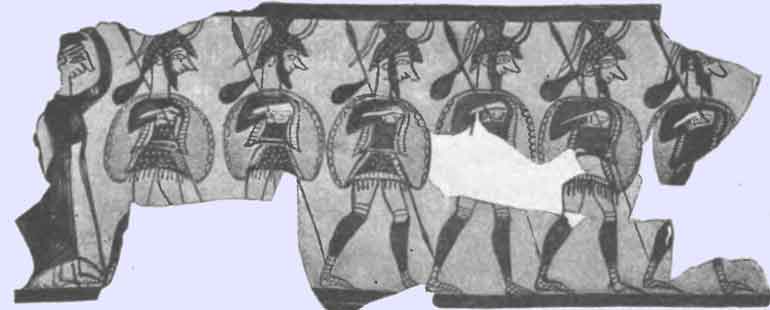
Mycenean Soldiers with a bottle wine on their spears as the poet Archilochus explains in his poem
The Mycenaean period fell between the arrival of the Greeks in the Aegean around 1600 BC and the collapse of their Bronze Age civilization around 1100 BC. The collapse is commonly attributed to the Dorian invasion, though some archaeologists and historians doubt that any such invasion took place.
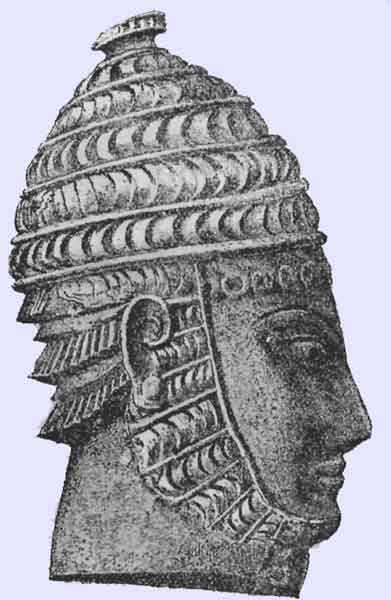
Mycenaean Helmet (Ivory Head sculpture)
Mycenaean civilization was dominated by a warrior aristocracy. Around 1400 BC the Mycenaeans extended their control to Crete, center of the Minoan civilization, and adopted a form the Minoan script called Linear A to write their early form of Greek. The Mycenaean era script is called Linear B.
The Mycenaeans buried their nobles in beehive tombs (tholoi), large circular burial chambers with a high vaulted roof and straight entry passage lined with stone. They often buried daggers or some other form of military equipment with the deceased. The nobility were frequently buried with gold masks, tiaras, armour, and jeweled weapons. Mycenaeans were buried in a sitting position, and some of the nobility underwent mummification.
Around 1100 BC the Mycenaean civilisation collapsed. Numerous cities were sacked and the region entered what historians see as a dark age. During this period Greece experienced decreasing population and they lost their literacy. Historians have traditionally blamed this decline on an invasion by another wave of Greek people, the Dorians, although the historical validity of this theory is now doubted.
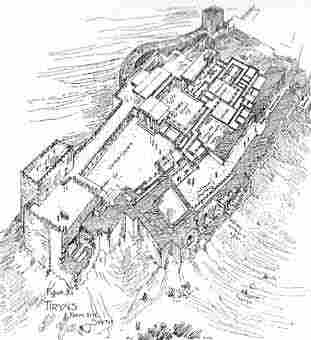
Citadel of Tiryns
Archaeology
The pottery is characterised by dark paintings on a light background. The beginnings of the Mycenean decorated pottery on the Greek mainland date to the beginning of the Late Bronze Age (Late Helladic I). The typology of the Mycenean pottery was created by the Swedish archaeologist Arne Furumark based on the material from the excavations of Asine. He provided a list of pottery-shapes as well (Furumark 1-333) that is used internationally in the description of Mycenean and Minoan pottery.
|
|
Psi - figurines |
|
|
|
|
|
|
|
|
|

|
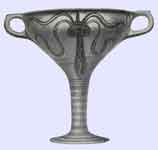
|

Men from Keftiu (maybe Minoans or Mycenaeans with gifts?) |
|
|

Table 1 provides the approximate dates of the Late Helladic phases (LH) on the Greek Mainland.
Approx. date Period
1000 protogeometric
1000-–1060 submycenean
1090–-1060 LHIIIC late
1130–-1090 LHIIIC middle
1190–-1130 LHIIIC early
1320–-1190 LHIIIB2
1300–-1320 LHIIIB1
1350-–1300 LHIIIA2
1400–-1350 LHIIIA1
1450–-1400 LHIIB
1500–-1450 LHIIA
1550–-1500 LHI
LHI
The LHI pottery is known from the fill of the shaft graves of Lerna and the settlements of Voroulia and Nichoria (Messenia), Ayios Stephanos, (Laconia) and Korakou. Furumark divided the LH in phases A and B, but Furumark's LHIB has been reassigned to LHIIA by Dickinson.
LHII
The description of the LHIIA is mainly based on the material from Kourakou East Alley. Domestic and Palatial shapes are distinguished. LHIIB sees a lessening of Cretan influences. Pure LHIIB assemblages are rare and originate from Tiryns, Asine and Korakou.
LHIII
The uniform and widely spread LHIIIIA1 pottery was originally defined by the material from the Ramp house at Mycenae, the palace at Thebes (now dated to LHIIIA2 or LHIIIB by most researchers) and Triada at Rhodes. There is material from Asine, Athens (wells), Sparta (Menelaion), Nichoria and the 'Atreus Bothros', rubbish sealed under the Dromos of the Treasury of Atreus at Mycenae as well.
The LHIIIA2 pottery marks a Mycenaen expansion covering most of the Eastern Mediterranean. There are many new shapes. The motifs of the painted pottery continue from LHIIIA1 but show a great deal of standartisation.
The definition of the LHIIIB by Furumark was mainly based on grave finds and the settlement material from Zygouries. It has been divided into two subphases by E. French, based on the finds from Mycenae and the West wall at Tiryns.
LHIIIB2 assemblages are sparse, as painted pottery is rare in tombs and many settlements of this period ended by destruction, leaving few complete pots behind.
The dating of the LH IIIC hinges on the destruction of Ugarit. The beginning of LH IIIC is now commonly set into the reign of Queen Twosret. The LHIIIC has been divided into LHIIIC1 and 2 by Furumark, based on materials from tombs in Mycenae, Asine, Kephallonia and Rhodes. In the 1960ies, the excavations of the Citadel at Mycenae and of Lefkandi in Euboia yielded stratified material that allowed the subdivision of the LHIIIC into three phases. There is a lot of regional variation in the LCIII, especially in the later phases. Late LH CIII pottery is found in Troy VIIa and a few pieces in Tarsus.

A Mycenaean funeral mask known as the "Mask of Agamemnon"
Submycenean
The submycenean pottery (called LHIIIC2 by Furumark) already belongs to the early Iron age. It is best known from the cemeteries of Kerameikos in Athens, Salamis in Attica and Skoubris in Lefkandi (Euboia) and the settlements of Athens (Agora), Tiryns and Mycenae. The term was introduced in 1934 by T. C. Skeat.
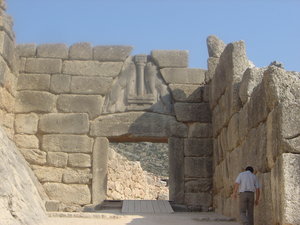
The Lion Gate at Mycenae
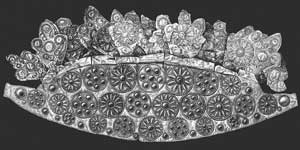
Mycenaen Gold
See also
Mycenae, Mycenaean language, Linear B
Achaeans
Helladic, Bronze Age
Aegean civilization
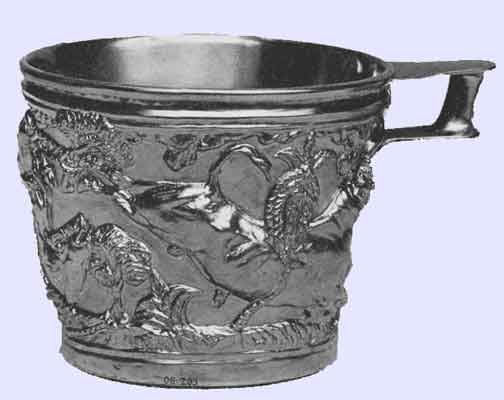
Mycenaean Vaphio Cup, c. 1500 BC
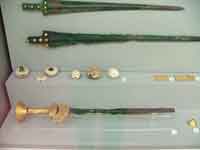
Further reading
- Chadwick, John (1976). The Mycenaean World. Cambridge UP. ISBN 0521290376.
- Mountjoy, P.A. (1986). Mycenaean Decorated Pottery: A Guide to Identification. Studies in Mediterranean Archaeology 73. Göteborg: Paul Åströms Forlag. ISBN 9186098322.
- Mylonas, George E. (1966). Mycenae and the Mycenaean Age. Princeton UP. ISBN 0691035237.
- Podzuweit, Christian (1982). "Die mykenische Welt und Troja". In: B. Hänsel (ed.), Südosteuropa zwischen 1600 und 1000 v. Chr., 65-88.
- Taylour, Lord William (1964). The Mycenaeans. Revised edition (1990). London: Thames & Hudson. ISBN 0500275866.
- Nicolas Grguric, Angus McBride (Illustrator), The Mycenaeans C.1650-1100 BC (Elite S.) -, Osprey Books (NY) (September 30, 2005) . ISBN: 1841768979
Links
- The Nemea Valley Archaeological Project: Internet Edition
- Tsoungiza C-14 Dates
- Gods found in Mycenaean Greece: a table drawn up from Michael Ventris and John Chadwick, Documents in Mycenaean Greek second edition (Cambridge 1973)

394 : Bronze dagger with inlaid decoration

1429 : Funerary stele made of poros stone, with relief chariot scene, Mycenae.
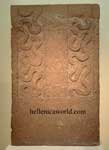
1430 : Funerary stele made of poros stone, with distinctive relief scene, Mycenae.
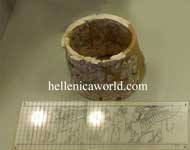
2476 : Ivory pyxis with representation of a man leading a sphinx

3256 : Funerary stele with painted scenes, Mycenae
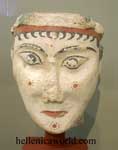
4575 : A unique plaster head of a woman, Mycenaean plastic art.
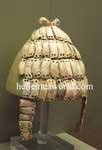
6507, 6568 : Boar's tusk helmet with cheek-guards and a double bone hook on top
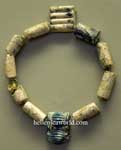
6536 : Necklace made of glass beads
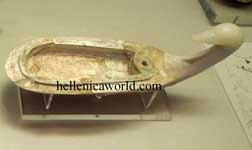
9506 : Elegant duck-shaped ivory pyxis
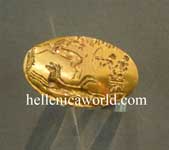
Gold signet ring with hunting scene
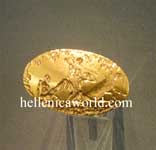
Gold signet ring with military scene
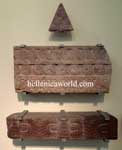

Reconstruction of the facade of the Treasury of Atreus,

Development of Mycenaean Pottery
See also
Mycenaean language
Linear B
Achaeans (Homer)
Helladic
Bronze Age
Aegean civilization
Greek Dark Ages
References
^ The extent to which Homer attempted to or succeeded in recreating a "Mycenaean" setting is examined in Moses I. Finley The World of Odysseus, 1954, rev. ed. 1978.
^ Hammond, N.G.L. (1976). Migrations and invasions in Greece and adjacent areas. Park Ridge, N.J.: Noyes P.. p. 139. ISBN 978-0-8155-5047-1.
^ Tandy, p. xii. "Figure 1: Map of Epirus showing the locations of known sites with Mycenaean remains"; Tandy, p. 2. "The strongest evidence for Mycenaean presence in Epirus is found in the coastal zone of the lower Acheron River, which in antiquity emptied into a bay on the Ionian coast known from ancient sources as Glykys Limin (Figure 2-A)."
^ Borza, Eugene N. (1990). In the shadow of Olympus : the emergence of Macedon ([Nachdr.] ed.). Princeton, NJ: Princeton University Press. p. 64. ISBN 978-0-691-00880-6.
^ Aegeobalkan Prehistory - Mycenaean Sites
^ The Synchronisation of Civilisations in the Eastern Mediterranean in the Second Millennium B.C. III, Proceedings of the SCIEM 2000 – 2nd EuroConference, Vienna, 28th of May – 1st of June 2003
^ Use and appreciation of Mycenaean pottery in the Levant, Cyprus and Italy, Gert Jan van Wijngaarden, Amsterdam Archaeological Studies
^ The Mycenaeans and Italy: the archaeological and archaeometric ceramic evidence, University of Glasgow, Department of Archaeology
^ Emilio Peruzzi, Mycenaeans in early Latium, (Incunabula Graeca 75), Edizioni dell'Ateneo & Bizzarri, Roma, 1980
^ Boston University - The Historical Society
^ Amber object bearing Linear B symbols, from Freising district, Germany, excavations in the years 1994 - 1997
^ The Ancient Greeks: An Introduction, Stephanie Lynn Budin, Oxford University press
^ The Celtic Encyclopedia
^ The Encyclopedia Americana, Volume 13
^ Bryan Avery Feuer, Mycenaean civilization: an annotated bibliography through 2002, McFarland & Co Inc, 2004
^ Burkert, Walter. Greek Religion, p. 121; Meyer, E. RE Suppl. XIV, pp. 813–815.
^ See sources cited at Homeric Troy.
^ For a fuller synopsis of Mycenaean frescoes, see the relevant section of Prehistoric Archaeology of the Aegean, Dartmouth College.
^ Chadwick John.(1976).The Mycenean world.Cambridge University Press.p 178 ISBN 0-521-21077-1
^ Translation of the Sins of Madduwatta
^ Skeat, T.C., The Dorians in Archeology, (London: Alexander Moring) 1934.
^ Oliver Dickinson, "The Aegean from Bronze Age to Iron Age", London 2006, 14-15.
^ Hans G. Güterbock, "The Hittites and the Aegean World: Part 1. The Ahhiyawa Problem Reconsidered" American Journal of Archaeology 87.2 (April 1983), pp. 133–138; and Machteld J. Mellink, "Part 2. Archaeological Comments on Ahhiyawa-Achaians in Western Anatolia", pp. 138–141.
^ G.L. Huxley, Achaeans and Greeks (1960); see Achaeans (Homer)#Hittite documents.
^ Translation of the Tawagalawa Letter
^ Hans G. Güterbock, "Hittites and Akhaeans: A New Look" Proceedings of the American Philosophical Society 128.2 (June 1984), pp. 114–122. Bibliography.
^ Hermann Bengtson: Griechische Geschichte. C.H.Beck, München, 2002. 9th Edition. ISBN 3-406-02503-X. pp.15-25
^ J.C.M De La Cruz, "Mykenische Keramik aus Bronzezeitlichen Siedlungsschichten von Montoro am Guadalquivir", MM 29 (1988) 77-92.pl 9.b-d.
^ The first Western Greeks, David Ridgway, Cambridge University Press, 1993
^ Miriam S. Balmuth, Robert J. Rowland, Studies in Sardinian archaeology, University of Michigan Press, 1984
^ Bryan Feuer, Mycenaean civilization: an annotated bibliography through 2002, McFarland & Company; Rev Sub edition (March 2, 2004)
^ Lord William Taylour, Mycenaean Pottery in Italy and Adjacent Areas, Cambridge 1958
^ Gert Jan van Wijngaarden, Use and Appreciation of Mycenaean Pottery in the Levant, Cyprus and Italy (1600-1200 B.C.): The Significance of Context, Amsterdam Archaeological Studies, Amsterdam University Press, 2001
^ Andrea Vianello, Late Bronze Age Mycenaean and Italic Products in the West Mediterranean: A Social and Economic Analysis, (British Archaeological Reports International Series), British Archaeological Reports
^ Elizabeth A. Fisher, The Mycenaeans and Apulia. An Examination of Aegean Bronze Age Contacts with Apulia in Eastern Magna Grecia, Astrom, 1998
^ David Ridgway, The First Western Greeks, Cambridge University Press, 1993
^ Bryan Avery Feuer, Mycenaean civilization, McFarland, 2004
^ Reynold Higgins, Minoan and Mycenaean Art, Thames & Hudson, 1997
^ Mycenaean Pictorial Vase Painting, Harvard University Press, 1990
^ J.T. Hooker, Mycenaean Greece (States & Cities of Ancient Greece), Routledge & Kegan Paul ,1977
^ Trude Krakauer Dothan, Seymour Gitin, Amihay Mazar, Ephraim Stern, Mediterranean peoples in transition: thirteenth to early tenth centuries BCE, Israel Exploration Society, Israel, 1998
^ Rodney Castleden, The Mycenaeans, Routledge, 2005
^ Preziosi, D. and Hitchcock L.A. (1999). Aegean Art and Architecture, p. 195.
^ Kyriakos Nikolaou, The first Myceneans in Cyprus, 1973
^ Acts of the International Arghaeological [sic] Symposium The Mycenaeans in the Eastern Mediterranean, Nicosia 27th March2nd April 1973, Department of Antiquities, Ministry of Communications and Works, Republic of Cyprus,
^ Barbara Kling, Mycenaean IIIC:1b and related pottery in Cyprus, P. Astroms Forlag, 1989
^ Jane Atwood Barlow, Diane L. Bolger, Diane R. Bolger, Barbara Kling, Cypriot Ceramics: Reading the Prehistoric Record, University of Pennsylvania Museum of Archaeology and Anthropology, 1992
^ Frank H. Stubbings, Mycenaean Pottery from the Levant, Cambridge University Press, 1951
^ Flinders Petrie, Tell el-Amarna, (London 1894)
^ Castleden (2005).
^ Chadwick 1976 "Religion", pp 84-102, p. 88.
^ Explicitly as expressed in M.P. Nilsson, The Minoan-Mycenaean Religion and Its Survival in Greek Religion, 1927.
^ Chadwick 1976:84.
^ "Words that are not understood are constantly deformed to give them meanings. Mere resemblance is of course nearly always deceptive." (Chadwick 1976:87).
^ Finley, The World of Odysseus 1954, rev. ed 1978)
^ Martin Nilsson (1967). p.339
^ Adams John Paul. Mycenean divinities.
^ Martin Nilsson (1940). The Greek Popular Religion
^ John Chadwick (1976): The Mycenean World. Cambridge University Press. p.76
^ Martin Nilsson. (1967). Die Geschichte der Griechische Religion Vol I. C.F.Beck Verlag. Munchen p.463
^ G Mylonas (1932). Eleusiniaka. I,1 ff.
^ Martin Nilsson (1967). p.475
^ Pausanias :VIII 25, 4-VIII 42 -VIII 37, 1ff. Martin Nilsson (1967) p.479-480
^ Martin Robertson (1959). La peinture Grecque. Edition d'art Albert Skira. Geneve p.31, National Archaeological Museum of Athens No 2665
^ Martin Nilsson (1967) p.293
^ Martin Nilsson (1967) pp.227,297
^ Pausanias VIII 37,6
^ Martin Nilsson (1967) pp.273,295
^ Martin Nilsson(1967).pp. 162,310,489
^ Martin Nilsson (1967).pp. 281,283,301,487.
^ Martin Nilsson(1967). pp.500-504
^ Martin Nilsson (1967). Vol I. pp. 565-568
^ Fraser. The golden bough. Adonis, Attis and Osiris. Martin Nilsson (1967). Vol I, pp. 215
^ Martin Nilsson (1967). Vol I, pp. 215-219
^ Wikander, p. 288.
^ Shear, p. 134.
^ E. B. French 1971 ‘The Development of Mycenaean Terracotta Figurines’, Annual of the British School of Archaeology at Athens 66, 101–87.
^ See account of their use in K.A. and Diana Wardle 'The Child's Cache at Assiros, Macedonia', in Sally Crawford and Gillian Shepherd (Eds): Children, Childhood and Society: Institute for Archaeology and Antiquity Interdisciplinary Studies Vol I Archaeopress, Oxford 2007.
^ Charbonneaux, J. and Demangel, M. Fouilles de Delphes ii, fascicule 2-3. Paris 1925. Hägg, R. ‘Official and Popular Cults in Mycenaean Greece’ in Sanctuaries and Cults in the Aegean Bronze Age, R. Hägg and N. Marinatos (eds.). Stockholm 1981.
^ . W.D. Taylour, E.B. French, K.A. Wardle. Well Built Mycenae Fasc 10: A.D. Moore, W.D. Taylour, The Temple Complex, Oxbow Books 1999
^ E.B. French in Colin Renfrew, The Archaeology of Cult: the Sanctuary at Phylakopi. British School at Athens Supplementary Vol. 18. London 1985
^ S. A. Immerwahr, Aegean Painting in the Bronze Age (University Park 1990)
^ W. Taylour, “Mycenae, 1968,” Antiquity 43 (1969), pp. 91-97; idem, “New Light on Mycenaean Religion,” Antiquity 44 (1970), pp. 270-280
^ Modern reconstruction of the Dendra panoply
^ K.A. and Diana Wardle, Cities of Legend, The Mycenaean World (London 2000) 69-70 and fig. 21
^ Mycenaean helmet
^ Homer, The Iliad, Book 10, 260-5
^ Mycenaean "figure eight" shield, fresco
^ Mycenaean "figure eight" shield, drawing
^ Mycenaean swords
^ Mycenaean Type G sword (Horn Sword)
^ Mycenaean dagger
^ W. Cavanagh and C. Mee, A Private Place: Death in Prehistoric Greece [SIMA 125] (Jonsered 1998)
^ W.D. Taylour, E.B. French, K.A. Wardle, 'Well Built Mycenae' Fasc 7, M. Alden The Prehistoric Cemetery: Pre-Mycenaean and Early Mycenaean Graves, Oxford 2000
^ O. Pelon, Tholoi, tumuli et cercles funéraires (Paris 1976)
^ Hammond, “Tumulus Burial in Albania, the Grave Circles of Mycenae, and the Indo-Europeans,” Annual of the British School at Athens, 62 (1967), p. 90.
^ Kazimierz Lewartowski, 'Late Helladic simple graves:a study of Mycenaean burial customs' BAR international series, no 878, Oxford 2000
^ Nikolas Papadimitriou, 'Built Chamber Tombs of Middle and Late Bronze Age Date in Mainland Greece and the Islands', BAR international series, no 925, Oxford 2001
^ See Graziado 1991 for a more comprehensive discussion of these trends, in addition to a sophisticated study of the grave goods in particular burials
Sources
Castleden, Rodney. The Mycenaeans. Routledge, 2005. ISBN 0-415-36336-5\
Chadwick, John (1976). The Mycenaean World. Cambridge UP. ISBN 0-521-29037-6.
Shear, Ione Mylonas. "Excavations on the Acropolis of Midea: Results of the Greek–Swedish Excavations under the Direction of Katie Demakopoulou and Paul Åström". American Journal of Archaeology, January 2000, 104(1):133–134.
Tandy, David W. Prehistory and History: Ethnicity, Class and Political Economy. Black Rose Books Ltd., 2001. ISBN 1-55164-188-7
Wikander, Örjan. "Archaic Roof Tiles the First Generations". Hesperia, 59(1):285–290, January–March, 1990.
Further reading
French, Elizabeth (2002). Mycenae: Agamemnon's Capital. Tempus. ISBN 0-7524-1951-X.
K.A. and Diana Wardle (1997, 2000). Cities of Legend: The Mycenaean World. Bristol Classical Press.
Burkert, Walter (1985). Greek Religion. Harvard University Press.
Mountjoy, P.A. (1986). Mycenaean Decorated Pottery: A Guide to Identification. Studies in Mediterranean Archaeology 73. Göteborg: Paul Åströms Forlag. ISBN 91-86098-32-2.
Mylonas, George E. (1966). Mycenae and the Mycenaean Age. Princeton UP. ISBN 0-691-03523-7.
Podzuweit, Christian (1982). "Die mykenische Welt und Troja". In: B. Hänsel (ed.), Südosteuropa zwischen 1600 und 1000 v. Chr., 65–88. (German)
Nur, Amos and Cline, Eric; (2000) "Poseidon's Horses: Plate Tectonics and Earthquake Storms in the Late Bronze Age Aegean and Eastern Mediterranean". Journ. of Archaeol. Sc., No. 27, pp. 43–63. [1]
Taylour, Lord William (1964). The Mycenaeans. Revised edition (1990). London: Thames & Hudson. ISBN 0-500-27586-6.
Weiss, Barry: (1982) "The decline of Late Bronze Age civilization as a possible response to climatic change" in Climatic Change ISSN 0165-0009 (Paper) 1573-1480 (Online), Volume 4, Number 2, June 1982, pp. 173–198.
| Ancient Greece
Science, Technology , Medicine , Warfare, , Biographies , Life , Cities/Places/Maps , Arts , Literature , Philosophy ,Olympics, Mythology , History , Images Medieval Greece / Byzantine Empire Science, Technology, Arts, , Warfare , Literature, Biographies, Icons, History Modern Greece Cities, Islands, Regions, Fauna/Flora ,Biographies , History , Warfare, Science/Technology, Literature, Music , Arts , Film/Actors , Sport , Fashion --- |
Retrieved from "http://en.wikipedia.org/"
All text is available under the terms of the GNU Free Documentation License

